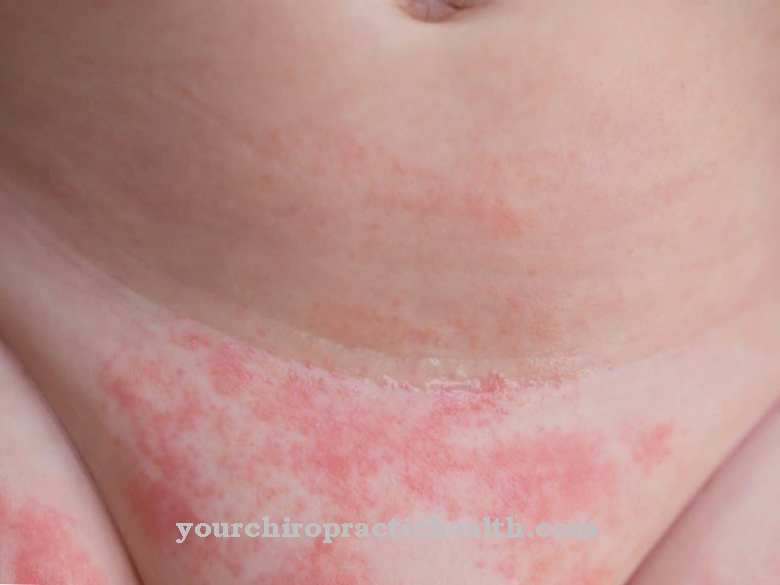lisp or Sigmatism is the term for a widespread and well-known language disorder. This phenomenon is particularly common in children. A special characteristic of lisp is the inadequate or phonetically deviating formation of the S and Z sounds when speaking.
What is lisp

© zaikina - stock.adobe.com
With small children can lisp be a normal phenomenon. Often, however, lisp is an expression of a language disorder in the person concerned. According to a scientific definition, lisp is one of the so-called articulation disorders. The term lisp is used to describe difficulties a person has in making sibilants (such as the 's' or the 'z').
There are several different forms of lisp. The most widespread is an impairment of the sound 's'. Since the Greek name for this letter is 'sigma', the corresponding form of lisp is also called sigmatism. People who are not affected by lisp in the form of a sigmatism usually form the 's' while keeping the tongue behind the teeth.
When lisping, however, the 's' is formed while the tongue is on or between the front teeth. If the lisp affects the formation of the sound 'sch' (in German-speaking countries), science speaks of Schetism; 'Chitism' is the name of a lisp that affects the formation of the sound 'ch'.
causes
A lisp can have different causes. Since children usually learn the sibilant sounds relatively late in their language development, lisp is a common phenomenon for them and is therefore usually not yet referred to as an articulation disorder in the narrower sense.
However, in some children a hearing impairment can also be concealed behind an occurring lisp; as a result, correct pronunciation of the sibilants is not possible. In those affected, lisp can also be caused or promoted by misalignment of the teeth or jaw (see jaw misalignment).
Disturbances of the muscles around the face can also lead to lisp. Other possible causes of lisp are not least symptoms of paralysis or tumors that affect the tongue or the oral cavity.
Symptoms, ailments & signs
The sound "s" cannot be formed correctly when lisping. Related sounds are often also affected, especially the “sch”, “z” and “ch”. Depending on which sounds cause difficulties for the person concerned, it is sigmatism, chitism or schetism.
One "s" weakness is known as sigmatism. People with this speech disorder often accentuate the "s" unintentionally. The sound sounds exaggerated, as a lot of air is forced out of the mouth uncontrollably when speaking. A whistling noise may also occur. Conversely, it is also possible that the "s" sounds too soft and is more reminiscent of the "th" from English.
In Chitism, the “ch” is formed incorrectly. Instead, the person concerned uses a "sch" or an "s", for example. If the lisp appears on the "sh", it is schetism. Here, too, the central symptom is the wrong sound formation. Those affected articulate the "sh" like "ch", "s", "t" or "d".
In addition, other complaints are possible that arise as a result of lisp. These secondary symptoms include shyness and lack of self-confidence. Both children and adults are often teased about the articulation disorder. However, this type of complaint is only indirectly related to lisp: it is not the lisp itself that is responsible, but how it is handled.
Diagnosis & course
lisp is diagnosed on the basis of the characteristically incorrect sound formation of an affected person. Here, lisping in the sense of a medically relevant articulation disorder in children is usually only made when a sufficient stage of language development has been reached.
If the person concerned suspects pathological processes on which the lisp is based (such as hearing or muscular disorders), this can be checked using appropriate diagnostic steps.
The course of a lisp varies depending on the person affected. A developmental lisp in children often subsides after their teeth change at the latest. However, if the lisp persists and / or is very pronounced, a diagnosis of the cause and a speech therapy treatment may become important in the course of the disease.
Complications
Lisp can lead to psychological complaints, especially in childhood. The speech impediment can encourage bullying and exclusion and as a result lead to reduced self-esteem and depression. Due to the speech inhibition, the lisp can intensify and the emotional complaints increase. This doesn't just apply to innate lisp.
Lisp, which has occurred after a stroke or a brain tumor, can also be a psychological burden for those affected. These problems are usually accompanied by physical complaints and concomitant illnesses, which, in connection with the offending illness, lead to a decrease in general well-being. As a result, further complications can arise that require independent treatment.
There can also be complications in the therapy of lisp. Tooth corrections can lead to instability of the entire periodontium. Oral surgery can be associated with bleeding, sensory disorders, and nerve damage. Since lisp can cause many complications, treatment of the speech disorder is recommended. Appropriate language training should be carried out quickly, especially with children who lisp, in order to avoid the development of psychological problems.
When should you go to the doctor?
A doctor does not always have to be consulted when lisp. In many cases, the phonetic disorder shows no medical value from a medical point of view and does not require treatment. This is based on the fact that there are usually no other physical or organic problems that could be treated. In the case of a slightly unclean or disturbed pronunciation, the person concerned can improve his or her way of speaking through independent practice. In some children, lisp results from a hearing impairment. A doctor's visit is therefore necessary in these cases as soon as hearing impairment occurs or a reduced hearing ability is perceived in the child.
In the case of misaligned teeth or irregularities in the jaw positions, a visit to a doctor is also advisable. If the changed sound formation is triggered by the dental apparatus, possible causes of the change can be discussed in a medical consultation. If the lisp is based on the temporary wearing of braces, the person affected should train specifically to speak with the foreign body in the mouth. No further visit to the doctor is required. If the lisp leads to emotional or psychological problems, it is advisable to consult a doctor. If you have decreased self-confidence, have behavioral problems or have problems in everyday contact with other people, a visit to a doctor is advisable. Targeted voice training can improve phonetics in speech therapy.
Treatment & Therapy
Due to the importance of the tooth change for the course of the Lisps In the case of children, experts often advise that treatment of lisp should not begin until the permanent front teeth have been fully developed.
Whether therapy is actually sought for a corresponding child or an adult must usually be discussed in consultation with a treating doctor. Adults who want to have their lisp treated are usually suffering from the articulation disorder.
A commonly used method to treat lisp is speech therapy (voice therapy). Depending on the form in which a lisp occurs, such therapy primarily includes training in correct sound formation. But also medical and, if necessary, psychological advice are often part of the lisp therapy concept. Especially in children, lisp can usually be treated successfully.
If a lisp is based on physical factors such as misalignments in the mouth, injuries or various illnesses that can impair hearing and speech, an important therapy component is the treatment of this underlying problem. In these cases, treatment of the cause and speech therapy often complement each other.
You can find your medication here
➔ Medicines to improve concentration and language skillsOutlook & forecast
The greatest chance to permanently remedy the lisp is in the context of therapy in childhood. Treatment should not be started immediately. Research into the causes has to occupy a large area. Because sometimes the lisp goes away on its own. If a misalignment of the teeth encourages lisp, for example, the loss of milk teeth can solve the problem without therapy.
If, on the other hand, paralysis of the tongue proves to be the cause, the prognosis is rather poor. Speech therapy support can help to form similar sounds. A high degree of mobility significantly improves the prospect of conflict-free communication. The faulty sound generation remains audible. If the lisp results from hearing problems, the success depends on the relief of the partial deafness. If aids can remedy the perception deficit, speech therapists work successfully with the patient on sound formation.
The extent to which lisp has an effect on professional success is controversial. Prominent examples seem to disprove possible drawbacks. The fact is, however, that children with a language disorder are more likely to experience exclusion than their peers with flawless pronunciation. There is a risk of decreased self-esteem and isolation. Therefore, parents should keep an eye on their child's language skills.
prevention
Can be prevented lisp in different ways. For example, early hearing tests in infants can reduce the risk of lisp later. Treating any misaligned teeth or other health problems that can encourage lisp often also has a preventive effect. A clear pronunciation of the caregivers can also counteract a lisp in the child.
Aftercare
Whether aftercare is even necessary for a treated articulation disorder depends on the individual case. In general, forms of dyslalia treated in childhood have an excellent prognosis and the therapies are considered effective. Relapses are rare but possible. This often depends on the personal circumstances and on a possible psychological stress.
Follow-up care in the broadest sense would consist of occasional further visits to therapy offers. In addition, exercises for self-control can be used, which those affected can continue to solve their dyslalia even after the therapy in order to constantly control themselves. Control examinations are usually not necessary, as a flare-up articulation disorder can be noticed by the person concerned and by those around him.
None of the therapeutic and speech therapy measures include medication, so there is no need for follow-up care. Under certain circumstances, there is an increased psychological stress due to the lisp. This is mostly due to the reactions of the environment as well as own uncertainties. In such cases, aftercare can also include rebuilding and strengthening a lack of self-confidence.
You can do that yourself
In many cases, you can take action against lisp. In the case of a weak articulation disorder, it is usually sufficient to carry out regular speaking exercises in order to improve the articulation after and nac. An example: place the tongue just behind the teeth on the throat and consciously practice the clean "S". Other letters and words can also be practiced in this way and should lead to better pronunciation with regular practice in front of the mirror.
If the lisp is caused by fixed braces, only patience will help. As soon as the device is removed, pronunciation usually improves and the lisp will go away on its own.
If the measures mentioned don't work, a speech therapist can help. He can suggest special exercises against lisp and give further tips and assistance for a clear pronunciation. Nevertheless, it is sometimes necessary to take action against the lisp - for example, if a malalignment in the oral cavity or a disease triggers the articulation disorder. Which means and ways are available in detail is best clarified in the context of a speech therapy consultation.



.jpg)























